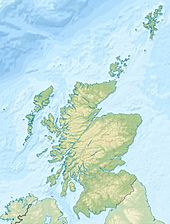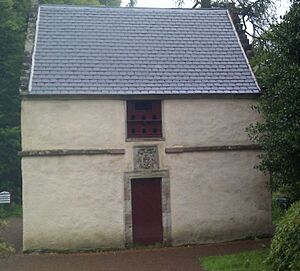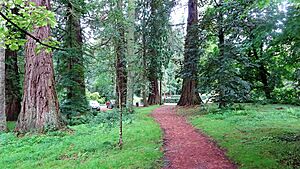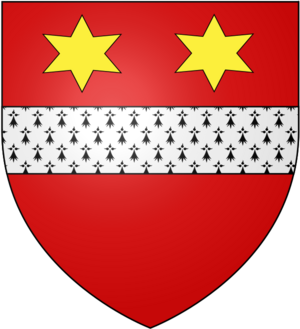Lefnoreis Castle facts for kids
Quick facts for kids Lefnoreis Castle |
|
|---|---|
| Cumnock, East Ayrshire, Scotland UK |
|
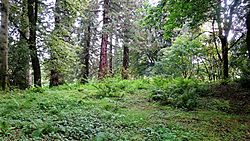
The site of Lefnoreis or Ward of Lochnorris Castle
|
|
| Coordinates | 55°27′24″N 4°18′43″W / 55.456614°N 4.3118274°W |
| Type | Tower |
| Site information | |
| Owner | Great Steward of Scotland Trust |
| Open to the public |
Yes |
| Condition | No remnants |
| Site history | |
| Built | 13th century |
| Built by | Craufurds |
| In use | 13th to early 17th century |
| Materials | Stone |
Lefnoreis Castle, also known as the Ward of Lochnorris, was an old castle in East Ayrshire, Scotland. It was located near Dumfries House in the Parish of Old Cumnock. The castle stood on a natural hill overlooking the Lugar Water.
The powerful Craufurd family built and owned this castle for many years. Today, there are no parts of the castle left to see.
Contents
History of Lefnoreis Castle
Lefnoreis Castle was the most important of three castles in the area of Old Cumnock. The other two were Borland Castle and Terringzean Castle.
Some people think there might have been two castles. One was near the current stables of Dumfries House. Its foundations could still be seen in 1885. The other castle was thought to be somewhere else on the estate. It was abandoned before 1635, and no traces of it remain today.
Understanding the Castle's Name
The castle's name has been spelled in many different ways over time. You might see it as Lefnoreis, Lochnorris, Ward of Lefnorris, or Tower of Leifnorris. On old maps, it appeared as Lesno in the 1600s and later as Lissnorris.
The different spellings happened because of how letters were written long ago. The letter 's' often looked like an 'f'. This made it easy to confuse the two letters. So, Lissnorris might have looked like Liffnorris to some people. The name was probably meant to sound more like Lesnories.
What "Ward" Means
It's unusual for a castle to have "Ward" in its name. In old Scottish law, "Ward" was a way of owning land. It meant that a family had to provide military service to their lord.
If the owner of the land died and their child was too young to fight, the lord would take care of the land. The lord would collect money from the land until the child grew up. So, the name "Ward" might have been used when the castle was managed this way.
What Lefnoreis Castle Looked Like
Lefnoreis was a strong tower, sometimes called 'the Ward'. In 1897, people dug up the castle site. They found parts of strong walls and a path made of water-worn stones.
In 1885, you could still see the castle's foundations above the ground. The building was taken down around 1759. The old walled garden of Lefnoreis was near the Lady's Well, which flows into the Lugar Water.
The dovecote at Dumfries House is the oldest building on the estate. It was built in 1671, around the same time as Lefnoreis Castle. A dovecote is a building where pigeons or doves are kept. The one at Dumfries House was restored in 1851.
The Lady's Well is west of the castle site. It was first mentioned in 1756, but its name suggests it's much older. The well was a small square building with arches and a pyramid roof until 1944.
The Craufurd family also owned land in other areas like Ochiltree and Dalmellington. Some of their lands were called Blackettle and Beauch.
The Craufurd Family of Lefnoreis
The first known owners of Lefnoreis Castle were the Craufurds in 1440. They were a branch of the Craufurd family from Loudoun Castle. The Craufurds owned the estate until 1635.
In 1635, William, the 2nd Earl of Dumfries, bought the castle. Later, his daughter Penelope married into the Dalrymple family. This is how the Dumfries title passed to them. Eventually, the Crichton-Stuarts family, who were Marquesses of Bute, inherited Dumfries House and its land.
The Craufurds of Lefnoreis had their own coat of arms. It was a red shield with a horizontal band of ermine fur across it. Above the band were two gold stars.
Dumfries House
William Dalrymple, the 5th Earl of Dumfries, decided to build a new home. He hired famous architects John, Robert, and James Adam to design Dumfries House. It was built between 1754 and 1759.
When Dumfries House was finished, the old Lefnoreis Castle was no longer needed. Its stones were taken away and likely used for other buildings.
Images for kids


